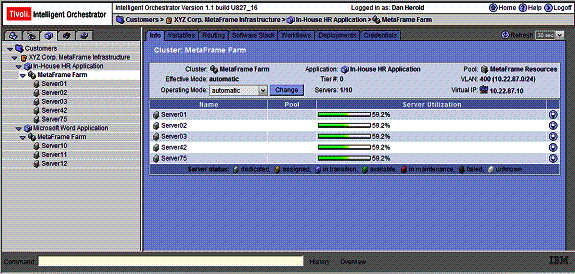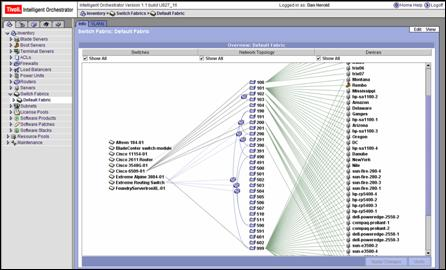| Tool Mentor: TIO - Supervise Tuning and Capacity Delivery |
 |
|
| Related Elements |
|---|
ContextTool mentors explain how a tool can perform tasks, which are part of ITUP processes and activities. The tasks are listed as Related Elements in the Relationships section. You can see the details of how processes and activities are supported by this tool mentor, by clicking the links next to the icons: DetailsThe IBM® Tivoli® Intelligent Orchestrator relies on metrics that are provided by the data acquisition engine to make decisions with respect to resource demand. Using real-time metrics and measured various industry-standard monitoring methods (SNMP, JMX, and so on), TIO is able to measure and respond to real-time changes within an application or infrastructure. Resource utilization metrics that are measured through the Tivoli Intelligent Orchestrator interface are visually represented within the Tivoli Intelligent Orchestrator Web management interface as shown in Figure 1 below.
Managing short-term resource demand can be satisfied by the administrator signing onto the Web management interface and manually assigning additional resources to a saturated application. Alternatively, the default operating mode of a particular application can be defined in such a way to respond automatically based on historical performance and key trends within the environment. Should resource allocation be required through an external process, Tivoli Intelligent Orchestrator has an externally available SOAP (Simple Object Access Protocol) interface. Should a server migration trigger need to come from an external source (such as a PERL script, external monitoring condition, or an administrative decision by a third-party tool), a SOAP message is passed to Tivoli Intelligent Orchestrator causing a workflow automation to automatically reassign the resource as required by the need. In much the same manner, should a device within the infrastructure fail unexpectedly, an external monitoring tool has the ability to remotely fail the device within Tivoli Intelligent Orchestrator using a Web services SOAP call. Failing the device within Tivoli Intelligent Orchestrator will automatically trigger contingency conditions whereby either a replacement is found to continue providing service, or alternatively notify the appropriate administrative staff to resolve the situation.
A short term, reactive solution can be quickly deployed using automation capabilities within the Tivoli Intelligent Orchestrator. Using automation functionality delivered within the product allows administrators the ability to quickly work with several leading third-party software and hardware resources. For example, using the information provided of the current operating environment, Tivoli Intelligent Orchestrator can automatically reconfigure network resources in response to a denial of service situation, runaway process, or virus threat. Given the automation capability provided out of the box, Tivoli Intelligent Orchestrator is able to communicate directly to a wide variety of leading network devices to assist with short term needs. For More InformationFor more information about this tool, click on the link for this tool at the top of this page. |
©Copyright IBM Corp. 2005, 2008. All Rights Reserved. |

